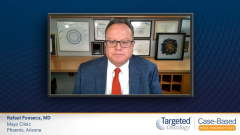
Initial Impressions: Goals and Challenges
Rafael Fonseca, MD, discusses the challenges of treating patients with newly diagnosed multiple myeloma.
Rafael Fonseca, MD: It is important to recognize that in patients of advanced age, more frequent than not, we will find patients that have standard risk factors. They don’t have some of the high-risk genetic factors which fortunately means patients will respond better to their therapies. As we look at newly diagnosed patients, most will have a survival that exceeds several to many years, including patients who will not receive stem cell transplant as an initial therapy.
It’s difficult to determine precise parameters for a prognosis, but we say that most with myeloma who are diagnosed in 2021 and undergo optimal induction therapy should have at least a 50% chance of being alive 10 years later. Of course, this becomes complicated in individuals of more advanced age because of competing comorbidities or what statisticians call competing causes for death but the prognosis continues to improve. Historically, for a patient like this, the goals of treatment would be, to provide some control but we have learned that treatments, even in the absence of a stem cell transplant, can result in very deep and durable responses.
That depth of response is important and seems to translate by most of what we’re seeing with the clinical trials in durable responses. The depth of response converts to durability, and that’s a very important point. The idea of being mild or palliative has moved forward over the last 5 years in thinking of, “Yes, let’s get a very long period of disease control with the best out there.” Of course, the third point is, what are the challenges that might present themselves in treating a patient like this? First and foremost, the health status of the person: how fit they are and their ability to withstand some of the rigors that come with therapy.Even though we think we have safe regimens, there is no question they come with some toxicity and baggage that needs to be dealt with, particularly in folks over the age of 75.
There needs to be a very deliberate and detailed explanation of what to expect with treatment with the patient and often with their family members. In my particular case, I like to do an early engagement with the rest of our team, such as the nursing team, pharmacists, and social workers. The ability of that patient to stay on treatment will first convert itself into disease control but then change into durability of that control, which should allow patients to resume more of their normal life activities.
Transcript edited for clarity.
Case: A 77-Year-Old Woman with Multiple Myeloma
Initial Presentation
- A 77-year-old woman presents with decreased appetites, fatigue, and back pain
- PMH: unremarkable
- PE: pain during ambulation, point tenderness on palpation of the mid-back
- ECOG 1
Clinical Workup
- Hb 9.2 g/dL, corrected calcium 11.8 mg/dL, LDH 285 U/L, creatinine 2.1 mg/dL, albumin 3.8 g/dL, CrCl 45 mL/min
- Peripheral blood smear showed rouleaux formation
- Beta-2 microgloblulin 4.2 mcg/mL, M-protein 2.5 g/dL
- Lambda free light chains: 0.7 mg/dL, kappa free light chains: 13.3 mg/dL
- FISH: hyperdiploid
- UPEP: M-spike of 410 mg of lambda light chains in 24 hours
- PET/CT revealed lytic bone lesions in at L2/L3
- Bone marrow biopsy shows 60% plasma cells IgG k
- Diagnosis: R-ISS stage II MM
Treatment
- Patient is ineligible for ASCT due to comorbidities
- Initiated treatment with daratumumab + bortezomib + lenalidomide + dexamethasone









































